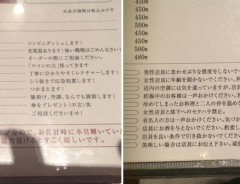
Source: othree CC by SA 2.0 / © flickr.com
Rengatei: venerable Ginza eaterie is birthplace of yōshoku classics like tonkatsu and omurice
Related Article
-

A Must-Visit Hidden Gem in Ginza: The Showa Retro Café Ginza N
-

“Cream Stew” is the latest flavor coming to Pringles cans in Japan
-

“Words Of Warning” Printed In The Menu That Had Gone Viral In Japan
-

Late Night Tokyo Food Stand Sells Traditionally Wrapped “Sushi Box” Sublime Kit Kats
-

Japanese train station has a “hidden restaurant” many people don’t know about
-

Yakiniku Sushi Is A Gourmet Sensation Fusing Sushi and Choice Meats Grilled At Your Table


Foodies often imagine that every country has its own distinctive eating habits. Ironically, the obsessive interest in national differences is one of the consequences of the globalisation of the world’s cuisines. In fact, national cuisines are usually hybrids of native and imported ingredients, and always have been.
Foodies also tend to think that eating ‘exotic’ food is something new, but snobby diners have been deriding their native cuisine and championing foreign food for centuries.
Japanese food is a case in point. Go to Los Angeles or Berlin, and diners associate Japanese food with sushi, tempura, tofu and udon. They don’t want to hear that Japanese people are just as likely to tuck into a cheap and cheerful curry (originally from India), a plate of gyoza (originally from China) or a burger (from Germany via the United States).
Yōshoku 洋食 is a good example. Although the name means ‘western food’, it’s a decidedly Japanese creation, and one with a long history. Yoshoku first became popular after the Meiji Revolution of 1868, when Japan was awash with all things western and urban sophisticates were desperate to sample the fruits of international trade, which had been banned for over 200 years.
One of the first restaurants in Japan to serve yōshoku was Rengatei 煉瓦亭 in Ginza, which was originally founded as a French restaurant in 1895. Rengatei claims to be the birthplace of two dishes that have come to be seen as quintessentially Japanese. The first is tonkatsu (豚カツ), and the second is omurice (オムライス).
Tonkatsu at Rengatei | zezebono from Ginza, Tokyo, CC BY-SA 2.0, via Wikimedia Commons
Tonkatsu is a thick cut of pork served with Worcester sauce, rice and shredded cabbage. The first tonkatsu was served at Rengatei by Motojiro Kida, its second-generation proprietor, in 1899. He based his signature dish on the Italian cotoletta, which is a veal cutlet coated in breadcrumbs and deep fried in vegetable oil.
This was a brave move, for western food was not widely popular at the time. Prior to 1868, most Japanese had been vegetarians, for Buddhism prohibited meat eating and even after the ban on meat was lifted, many Japanese continued to avoid western dishes in the belief that it caused heartburn.
However, the Japanese took to meat-eating with aplomb after the Meiji Revolution, in the belief that it would make them bigger and stronger. The Meiji Emperor even lent his support to the new carnivorous diet, and when the country was swept up on a wave of patriotic fervour during the Sino-Japanese of 1894 and again in 1904, when the Russo-Japanese War broke out, meat eating practically became a duty.
An Italian would have expected his cutlet to be served with cooked vegetables, but Rengatei’s head chef didn’t have this luxury. Vegetables took time to prepare and there was a labour shortage in Tokyo at the time. So Motojiro Kida garnished his pork cutlets with finely shredded cabbage, which was easier to prepare.
In the early days, Mr. Kida served his tonkatsu with bread, as a French chef might. But his customers found it hard to cut up pieces of bread with a knife and fork, so he began serving them rice instead. Shredded cabbage and rice have been standard accompaniments for tonkatsu ever since (these days, diners also expect a bowl of miso soup when they order tonkatsu).
Omurice at Rengatei | zezebono, CC BY-SA 2.0, via Wikimedia Commons
The other classic yoshoku dish first served at Rengatei is omurice, a portmanteau word that combines the English words ‘omelette’ and ‘rice.’ It is an egg omelette stuffed with fried rice and served with a healthy dollop of tomato ketchup.
Omurice quickly became a family favourite in Japanese homes, much loved by children, and was taken to Korea and Taiwan by Japanese colonialists in the first half of the 20th century, where it remains popular to this day.
Rengatei is still serving up delicious fusion food 125 years after it first opened and still serves delicious tonkatsu and omurice. They’re just two of the classic yōshoku dishes on the extensive menu and a visit is warmly recommended.